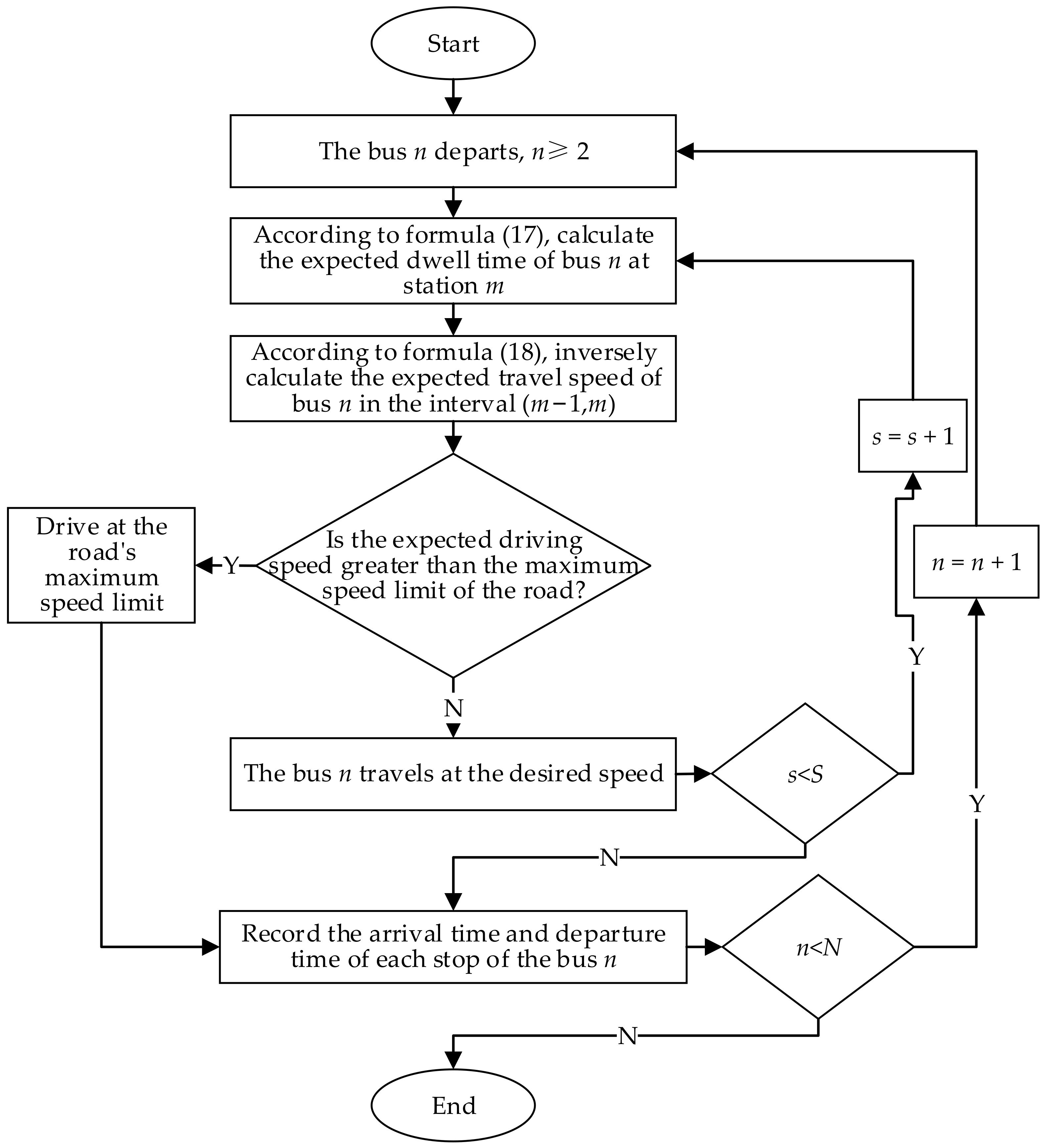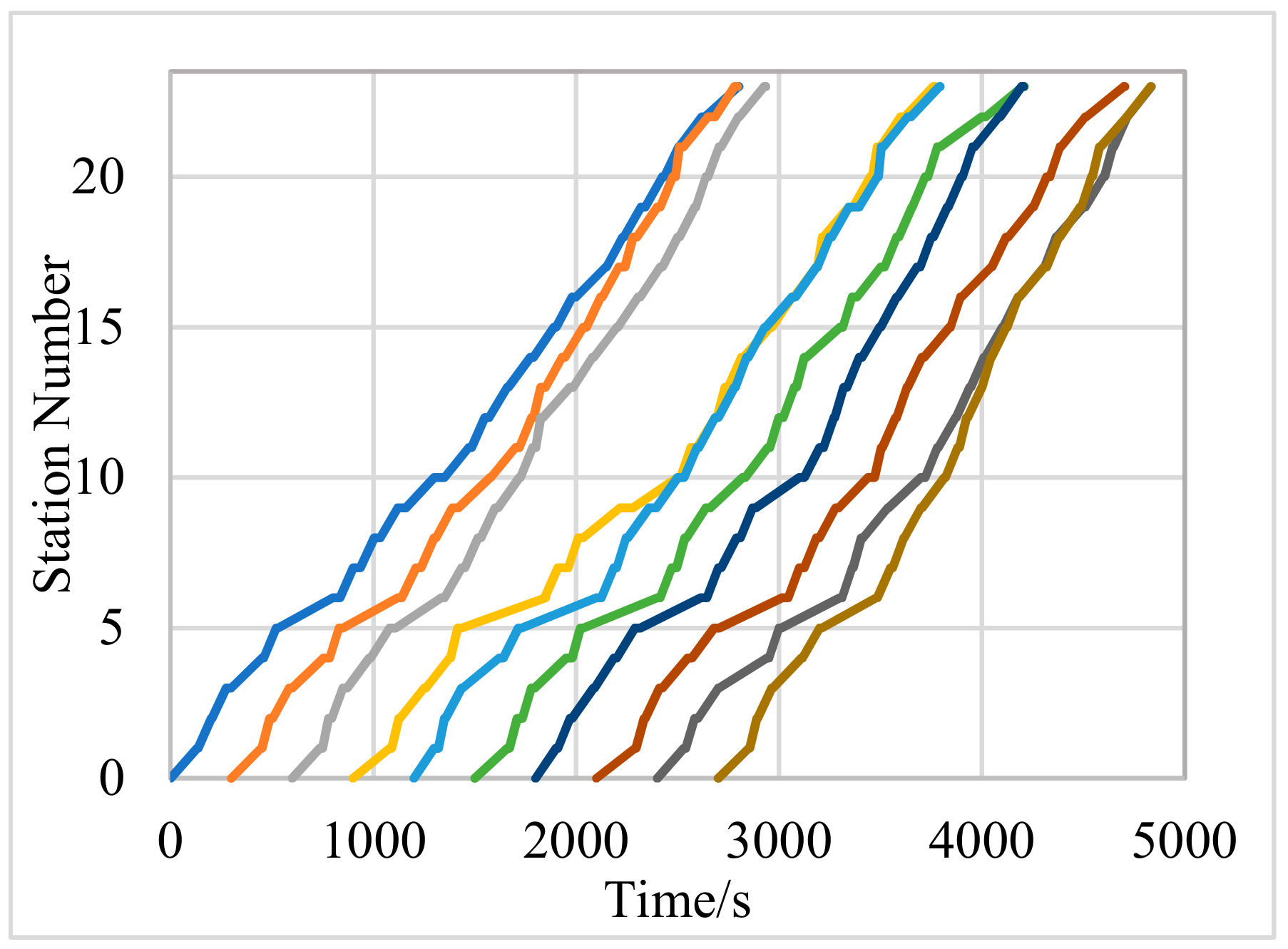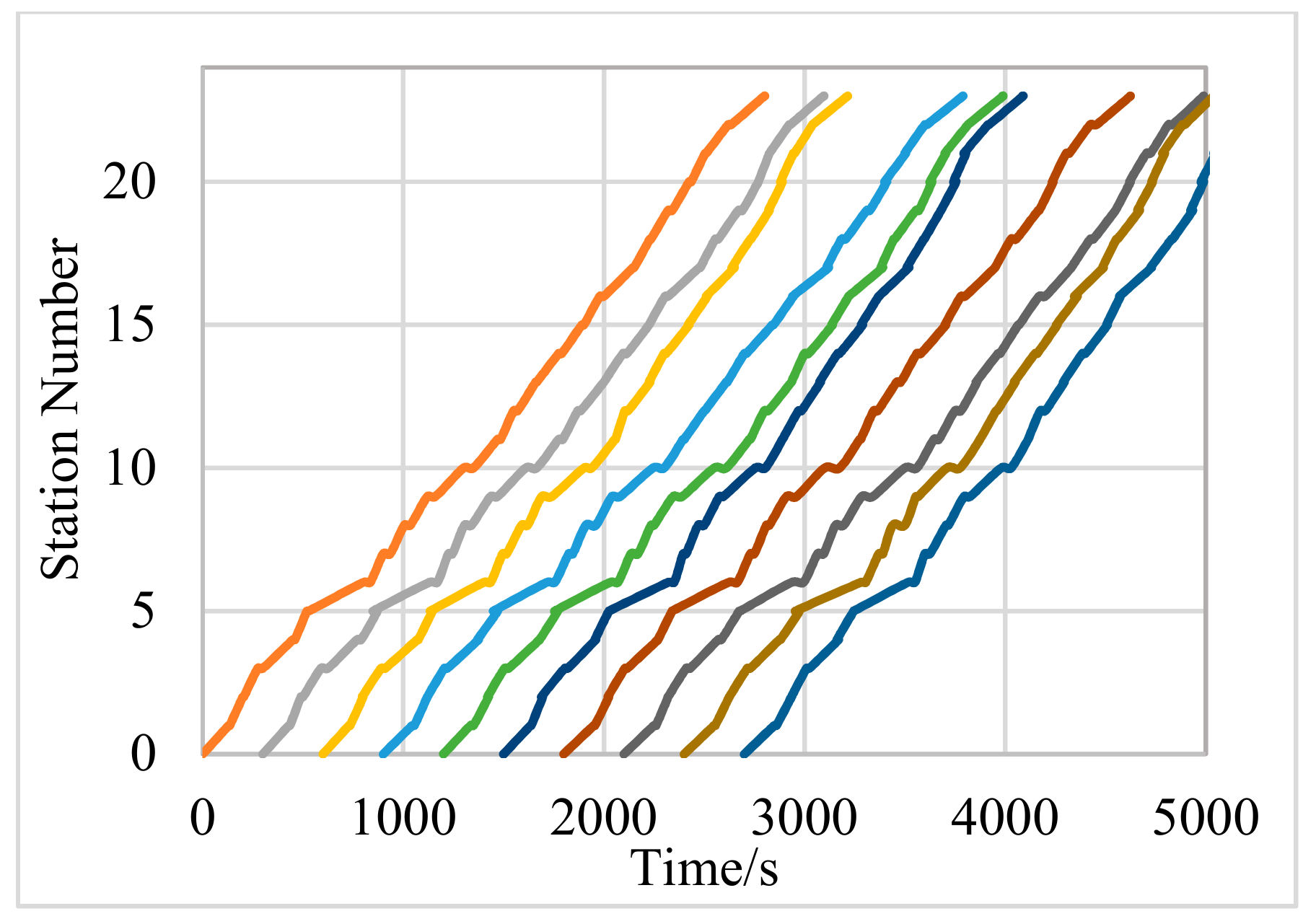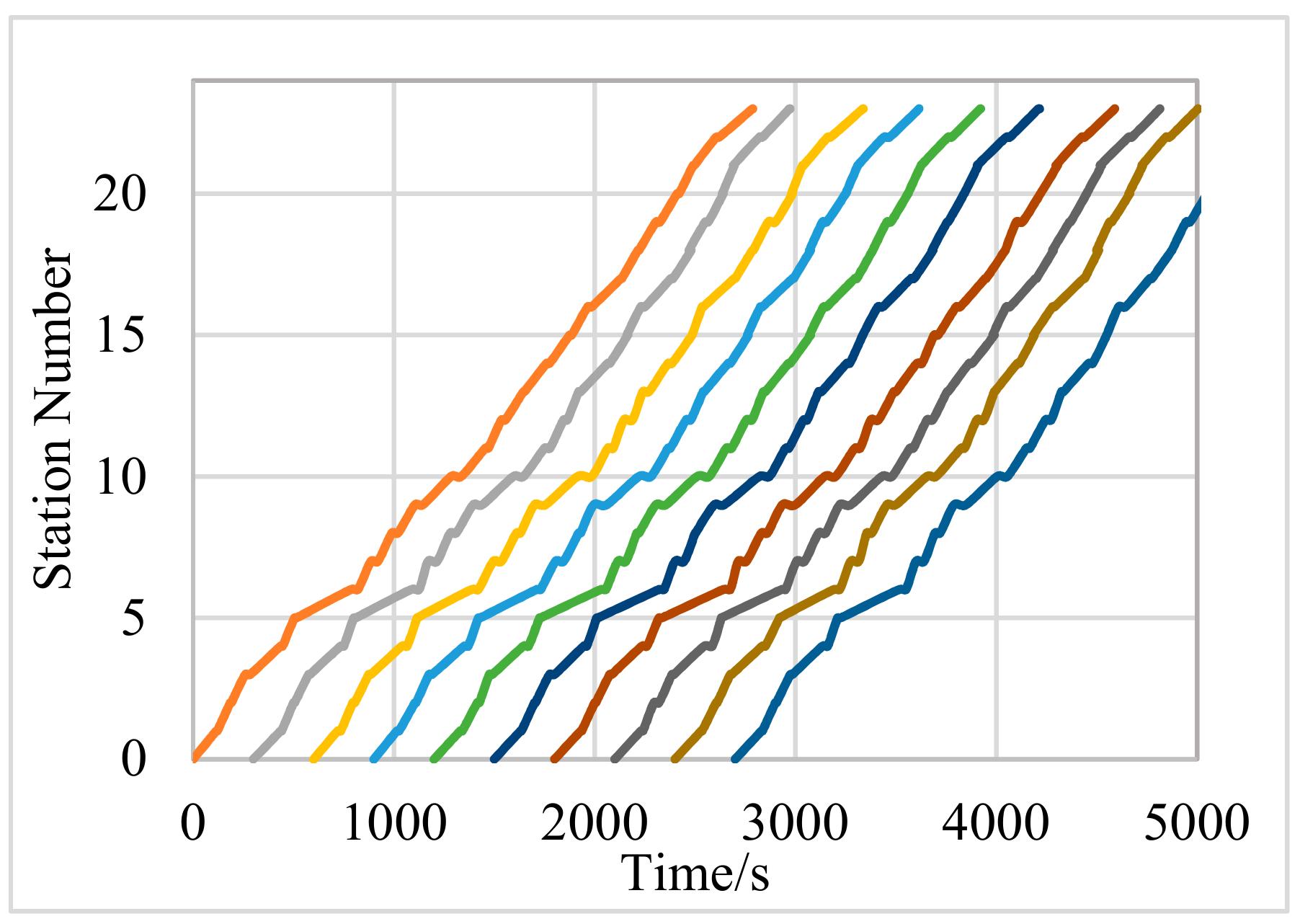A Real-Time Control Strategy for Bus Operation to Alleviate Bus Bunching
Abstract
1. Introduction
2. Bus Operation Model without Control Strategy
2.1. Bus Operating Rules
2.2. Bus Operation Evaluation
3. Control Strategies of Preventing Bus Bunching
3.1. Single-Point Control Based on Timetable
3.2. Multi-Point Control Based on Time Headway
3.3. Real-Time Control
3.3.1. Model Assumptions
- The bus route is a continuous idealized closed loop. The number of closed-loop bus vehicles running is N and the number of stops is M.
- Negligible vehicles stopping time at stations to open and close doors.
- Buses and drivers receiving and transmitting information and their performance are effectively synchronized during the bus operations process.
- The departure interval between the bus and the preceding vehicle is the optimum headway of the bus to be controlled.
- The information required for real-time bus control is obtained in real time through the Bus Information Management System (BIMS). The driver is able to control the operation of the bus at the desired travel speed.
3.3.2. Model and Solution
- Controlling model parameters
4. Case Study
4.1. Simulation Bus Route
- Survey method
4.2. Simulation Analysis
- No control
- S1
- S2
- S3
5. Conclusions
- Based on the timetable control strategy, for bus lines with long routes and many stops, it is difficult to avoid the bunching between control points. If the control points are added, the bus bunching can be reduced, but the dwell time in which the bus stays at the control point will be greatly increased. In this case, the average bus travel time increased by about 36%, and the operating efficiency of the bus was significantly reduced.
- The multi-point control strategy based on headway can solve the problem of when the control points increase, the bus operation efficiency drops sharply in the timetable-based control strategy, and at the same time improves the bus operation stability. This strategy is able to reduce operational delay by adjusting the speed of each vehicle between control points, thus reducing the additional stopping delays caused by additional boarding passengers.
- The real-time control strategy considers the impact of the bus load rate on the passengers’ boarding time, controls the stopping time of the vehicle at the station, and controls the cruising speed of the buses in real time, so that the headway of the buses is kept close to the optimal headway in real time. Through the above control measures, this control strategy achieves the effect of balanced operation of a bus line and can effectively prevent bus bunching from occurring.
- S1 adds slack time in the timetable to alleviate bus bunching, but it cannot prevent the spread of large local interruptions in the system. S2 adds a delay term at the control points based on the headway, and prevents the bus from colliding by controlling the running speed between the control points, which is more stable and faster than S1. The effect of S3 is equivalent to the combined version of S1 and S2. On the one hand, it ensures the planned operation timetable of the bus, and on the other, it maintains a better time headway of the bus. While following these two goals, the operating efficiency of the bus is indirectly improved.
- The three control strategies are based on the circumstance that buses do not overtake, to prevent buses from bunching, and to achieve a balanced and stable operation of buses. In real-time control, buses are controlled to travel at the desired speed in real time. However, in the actual operation process, there are delays caused by signal crossings and other traffic flows. How to smooth the speed curve of buses and achieve the feasibility of S3 is the focus of future study. In future research, it is necessary to analyze the details of buses traveling between stops, and consider a variety of bus scheduling methods, including bus overtaking and stop jumping, so as to improve the efficiency and attractiveness of bus operation and achieve sustainable development of public transport.
Author Contributions
Funding
Informed Consent Statement
Data Availability Statement
Acknowledgments
Conflicts of Interest
References
- Xu, L. Research on the policy guarantee mechanism of the sustainable and priority development of urban public transport. Urban Transp. China 2013, 13, 29–34. [Google Scholar] [CrossRef]
- He, S. An anti-bunching strategy to improve bus schedule and headway reliability by making use of the available accurate information. Comput. Ind. Eng. 2015, 85, 17–32. [Google Scholar] [CrossRef]
- Yao, D.; Xu, L.; Li, J. Public transport service level, traffic demand management and public transport attractiveness—A dual test based on objective choice and subjective intention. J. Syst. Manag. 2020, 29, 31–40. [Google Scholar]
- Newell, G.F.; Potts, R.B. Maintaining a bus schedule. In Proceedings of the 2nd Australian Road Research Board (ARRB), Melbourne, Australia, 1 January 1964. [Google Scholar]
- Osuna, E.E.; Newell, G.F. Control strategies for an idealized public transportation system. Transp. Sci. 1972, 6, 52–72. [Google Scholar] [CrossRef]
- Barnett, A. On controlling randomness in transit operations. Transp. Sci. 1974, 8, 102–116. [Google Scholar] [CrossRef]
- Abkowitz, M.; Eiger, A.; Engelstein, I. Optimal control of head-way variation on transit routes. J. Adv. Transp. 1986, 20, 73–88. [Google Scholar] [CrossRef]
- Li, Y.; Yang, H.; Zheng, C. Optimization of bus departure frequency based on passenger arrival rate. J. East China Jiaotong Univ. 2021, 38, 54–60. [Google Scholar]
- Daganzo, C.F. A headway-based approach to eliminate bus bunching: Systematic analysis and comparisons. Transp. Res. Part B Methodol. 2009, 43, 913–921. [Google Scholar] [CrossRef]
- Daganzo, C.F.; Pilachowski, J. Reducing bunching with bus-to-bus cooperation. Transp. Res. Part B Methodol. 2011, 45, 267–277. [Google Scholar] [CrossRef]
- Nesheli, M.M.; Ceder, A.A.; Gonzalez, V.A. Real-time public-transport operational tactics using synchronized transfers to eliminate vehicle bunching. IEEE Trans. Intell. Transp. Syst. 2016, 17, 3220–3229. [Google Scholar] [CrossRef]
- Zhang, J.; Li, M.; Ran, B.; Li, W. Causes and forecast modeling of conventional bus bunching. J. Southeast Univ. (Nat. Sci.) 2017, 47, 1269–1273. [Google Scholar]
- Zhang, P.; Li, W.; Chang, Y.; Xie, J. A multi-application optimal control model for intersection bus priority based on vehicle speed guidance. China J. Highw. Transp. 2017, 30, 109–115. [Google Scholar]
- Huang, Q.; Jia, B.; Qiang, S.; Xiao, Y. Research on combined bus control strategy based on stationing and flow restriction. J. Transp. Syst. Eng. Inf. Technol. 2018, 18, 103–109. [Google Scholar]
- Chandrasekar, P.; Cheu, R.L.; Chin, H.C. Simulation evaluation of route-based control of bus operations. J. Transp. Eng. 2002, 128, 519–527. [Google Scholar] [CrossRef]
- Teng, J.; Jin, W. A bus operation control method based on interval speed guidance. J. Tongji Univ. (Nat. Sci.) 2015, 43, 1194–1199. [Google Scholar]
- Teng, J.; Yang, X. A real-time control method for bus single line under APTS. J. Tongji Univ. (Nat. Sci.) 2006, 34, 744–747. [Google Scholar]
- Teng, J.; Yang, X. Research on real-time control-dispatch method for rapid transit under APTS. Syst. Eng.-Theory Pract. 2006, 2, 138–143. Available online: http://www.cqvip.com/QK/95538X/2006002/21308700.html (accessed on 20 May 2022).
- Teng, J.; Yang, X. A practical optimization method for urban bus hub scheduling problem under APTS. Syst. Eng. 2004, 22, 78–82. [Google Scholar] [CrossRef]
- Hu, T.; Chen, L. Impact of real-time information on dynamic vehicular flows under mixed traffic conditions. J. East. Asia Soc. Transp. 2007, 6, 1338–1353. [Google Scholar]
- Ismail, R.; Hafezi, M.H.; Ismail, A. Implementing specific lane length on bus route for operation delays reduction. J. Appl. Sci. 2012, 12, 2077–2081. [Google Scholar] [CrossRef][Green Version]
- Bhattacharyya, K.; Maitra, B.; Boltze, M. Implementation of bus priority with queue jump lane and pre-signal at urban intersections with mixed traffic operations: Lessons learned? Transp. Res. Rec. J. Transp. Res. Board 2019, 2673, 646–657. [Google Scholar] [CrossRef]
- Asgharzadeh, M.; Shafahi, Y. Real-time bus-holding control strategy to reduce passenger waiting time. Transp. Res. Rec. 2017, 2647, 9–16. [Google Scholar] [CrossRef]
- Berrebi, S.J.; Watkins, K.E.; Laval, J.A. A real-time bus dispatching policy to minimize passenger wait on a high frequency route. Transp. Res. Part B Methodol. 2015, 81, 377–389. [Google Scholar] [CrossRef]
- Berrebi, S.J.; Hans, E.; Chiabaut, N.; Laval, J.A.; Leclercq, L.; Watkins, K.E. Comparing bus holding methods with and without real-time predictions. Transp. Res. Part C Emerg. Technol. 2018, 87, 197–211. [Google Scholar] [CrossRef]
- Guler, S.I.; Menendez, M.; Meier, L. Using connected vehicle technology to improve the efficiency of intersections. Transp. Part C 2014, 46, 121–131. [Google Scholar] [CrossRef]
- Wang, Y.; Tan, G.; Liu, M.; Din, N. An adaptive priority approach for public transportation in a connected vehicle environment. J. Comput. Appl. 2016, 36, 2181–2186. [Google Scholar]
- Feng, Y.; Yu, C.; Henry, X. Spatiotemporal intersection control in a connected and automated vehicle environment. Transp. Res. Part C 2018, 89, 364–383. [Google Scholar] [CrossRef]
- Dosovitskiy, A.; Ros, G.; Codevilla, F.; Lopez, A.; Koltun, V. CARLA: An open urban driving simulator. arXiv 2017, arXiv:1711.03938. [Google Scholar]
- Xiang, Y.; Wang, S.; Su, T.; Li, J.; Mao, S.S.; Geimer, M. KIT bus: A shuttle model for CARLA simulator. In Proceedings of the IEEE Industrial Electronics and Applications Conference, Singapore, 24–26 May 2021; pp. 7–12. [Google Scholar] [CrossRef]
- Rong, G.; Shin, B.H.; Tabatabaee, H.; Lu, Q.; Lemke, S.; Moeiko, M.; Boise, E.; Uhm, G.; Gerow, M.; Mehta, S. LGSVL Simulator: A high-fidelity simulator for autonomous driving. arXiv 2020, arXiv:2005.03778. [Google Scholar]
- Kong, X.; Ren, C.; Gao, G.; Huon, Y. Evaluation on operation efficiency of urban transport system considering rail transit planning. Sci. Technol. Eng. 2020, 20, 5390–5395. [Google Scholar]
- Yan, H.; Liu, R. Short-tum vehicles departure strategy considering reliability of bus operation. J. South China Univ. Technol. (Nat. Sci. Ed.) 2019, 47, 25–32 + 43. [Google Scholar]
- Zhang, Y. Research and Case Evaluation of Operation Reliability of Conventional Public Transportation in Big Cities; Beijing Jiaotong University: Beijing, China, 2008. [Google Scholar]
- Xue, Y.; Zhong, M.; Xue, L.; Zhang, B.; Tu, H.; Tan, C.; Kong, Q.; Guan, H. Simulation analysis of bus passenger boarding and alighting behavior based on cellular automata. Sustainability 2022, 14, 2429. [Google Scholar] [CrossRef]
- Ma, C.; Wang, J. Traffic Survey and Analysis; China Communications Press: Beijing, China, 2016. [Google Scholar]








| Model Parameters | Parameter Meaning | No Control | S1 | S2 | S3 |
|---|---|---|---|---|---|
| Service headway | √ | √ | √ | √ | |
| Expected travel time of the bus from stop i to i + 1 | √ | √ | |||
| Departure time of the bus | √ | √ | |||
| Planned arrival time of bus n at stop s + 1 | √ | √ | |||
| Average travel time of the bus from stop s to s + 1 | √ | √ | √ | ||
| Random noise parameters | √ | √ | |||
| Errors generated by the disturbances | √ | √ | |||
| Moment when the bus n actually arrives at stop s | √ | √ | |||
| Uncontrolled average travel time of the bus from stop s to s + 1 | √ | ||||
| A dimensionless parameter | √ | ||||
| Time headway between bus n and n − 1 arriving at stop s | √ | √ | √ | ||
| Actual travel time from stop s to s + 1 | √ | √ | |||
| Standard deviation of noise terms | √ | ||||
| Delay parameter of time headway | √ | ||||
| Average delay | √ | ||||
| Control sensitivity, | √ | ||||
| Dwell time of bus n at stop s | √ | ||||
| Arrival rate of bus n passengers at stop s | √ | ||||
| Average boarding time of unit passenger taking bus n at stop s | √ | ||||
| Distance from bus stop s − 1 to s | √ | ||||
| Desired travel speed of the bus between bus stop s − 1 and s | √ | ||||
| Travel time of bus n between bus stop s − 1 and s | √ | ||||
| Departure time of bus n at stop s | √ |
| Stop Number | Bus Stop Name | Distance (km) | Drop-Off Rate (%) | Stop Number | Bus Stop Name | Distance (km) | Drop-Off Rate (%) |
|---|---|---|---|---|---|---|---|
| 0 | North Wenjiao Road | 0 | 0 | 12 | Lijing Road | 0.4 | 4.46 |
| 1 | North Xianshi Road II | 1.08 | 0.89 | 13 | North Cuiyuan Station | 0.53 | 5.36 |
| 2 | North Gate of the First Affiliated Hospital of Nanchang University | 0.34 | 1.79 | 14 | North Fenghe Interchange | 0.38 | 2.68 |
| 3 | Qingshan Road | 0.5 | 0.89 | 15 | South Fenghe Avenue | 0.66 | 3.57 |
| 4 | Children’s Hospital | 0.92 | 1.79 | 16 | Qianhu Branch of Nanchang University Affiliated Primary School | 0.5 | 1.79 |
| 5 | Provincial People’s Hospital | 0.43 | 2.68 | 17 | Hong Jiaozhou Management Committee | 0.85 | 5.36 |
| 6 | North Road of Honggu Central Avenue | 2.31 | 10.71 | 18 | Changgeng Road Lingkou Road Intersection | 0.34 | 4.46 |
| 7 | Chunhui Road | 0.33 | 6.25 | 19 | Xuefu Avenue Keyuan Road Intersection | 0.78 | 6.25 |
| 8 | West Road of Guangdian Branch | 0.48 | 4.46 | 20 | Jiangxi University of Science and Technology Hong Jiaozhou Campus | 0.2 | 4.46 |
| 9 | The Central at Dinfung | 0.55 | 5.36 | 21 | Xuefu Road | 0.34 | 3.57 |
| 10 | Shimao Road | 0.97 | 9.82 | 22 | North Gate, Qianhu Campus, Nanchang University | 0.91 | 3.57 |
| 11 | Yiyuan Road | 0.43 | 8.04 | 23 | Honggu New Town | 0.99 | 1.79 |
| Station Number | 17:00–17:15 | 17:15–17:30 | 17:30–17:45 | 17:45–18:00 | 18:00–18:15 | 18:15–18:30 | 18:30–18:45 | 18:45–19:00 |
|---|---|---|---|---|---|---|---|---|
| 0 | 1.2 | 1.3 | 1.4 | 1.4 | 1.3 | 1.3 | 1 | 0.9 |
| 1 | 1.6 | 1.9 | 2.4 | 2.3 | 2.5 | 2 | 1.7 | 1.2 |
| 2 | 1.8 | 1.6 | 1.7 | 1.7 | 1.4 | 1.4 | 1.3 | 1 |
| 3 | 2.7 | 2 | 1.6 | 1.9 | 1.8 | 1.6 | 1.7 | 1.7 |
| ┇ | ┇ | ┇ | ┇ | ┇ | ┇ | ┇ | ┇ | ┇ |
| 20 | 0.4 | 0.5 | 0.5 | 1.4 | 0.9 | 0.8 | 0.5 | 0.2 |
| 21 | 0.3 | 0.25 | 0.5 | 0.9 | 0.1 | 0.15 | 0.1 | 0.05 |
| 22 | 0.2 | 0.15 | 0.4 | 0.2 | 0.15 | 0.1 | 0.05 | 0.08 |
| 23 | 0 | 0 | 0 | 0 | 0 | 0 | 0 | 0 |
| Control Type | The Moment of First Bunching (min) | Average Travel Time (min) | Difference Value of Average Travel Time Compared to No Control | ||
|---|---|---|---|---|---|
| no control | 27 | 47 | 4.08 | ||
| S1 | 1 control point (starting point) | 27.4 | 50 | 3 | 2.58 |
| 3 control points | 28 | 56 | 9 | 8.87 | |
| 5 control points | ─ | 64 | 17 | 9.42 | |
| S2 | ─ | 53 | 6 | 0.47 | |
| S3 | ─ | 35 | −12 | 0.05 | |
Publisher’s Note: MDPI stays neutral with regard to jurisdictional claims in published maps and institutional affiliations. |
© 2022 by the authors. Licensee MDPI, Basel, Switzerland. This article is an open access article distributed under the terms and conditions of the Creative Commons Attribution (CC BY) license (https://creativecommons.org/licenses/by/4.0/).
Share and Cite
Xue, Y.; Zhong, M.; Xue, L.; Tu, H.; Tan, C.; Kong, Q.; Guan, H. A Real-Time Control Strategy for Bus Operation to Alleviate Bus Bunching. Sustainability 2022, 14, 7870. https://doi.org/10.3390/su14137870
Xue Y, Zhong M, Xue L, Tu H, Tan C, Kong Q, Guan H. A Real-Time Control Strategy for Bus Operation to Alleviate Bus Bunching. Sustainability. 2022; 14(13):7870. https://doi.org/10.3390/su14137870
Chicago/Turabian StyleXue, Yunqiang, Meng Zhong, Luowei Xue, Haokai Tu, Caifeng Tan, Qifang Kong, and Hongzhi Guan. 2022. "A Real-Time Control Strategy for Bus Operation to Alleviate Bus Bunching" Sustainability 14, no. 13: 7870. https://doi.org/10.3390/su14137870
APA StyleXue, Y., Zhong, M., Xue, L., Tu, H., Tan, C., Kong, Q., & Guan, H. (2022). A Real-Time Control Strategy for Bus Operation to Alleviate Bus Bunching. Sustainability, 14(13), 7870. https://doi.org/10.3390/su14137870







